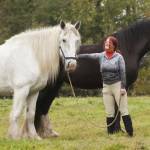Lice in Horses: Prevention and Treatment

Mosquitoes and other flying insects have been driving your horses crazy, and fly sprays don’t seem to give long-term protection. You’ve invested in lightweight turnout sheets and they have cut down on irritation from flies, but now you’ve noticed that the horses seem to be scratching their necks and shoulders against fences, trees, and stall walls. When you take the blankets off, you notice rough coats, rubbed patches, and matted manes. Looking more closely at the base of the mane hairs, you see tiny pale shapes moving on the skin. Could they be lice? Suddenly, you feel itchy, too!
Lice are somewhat more common in winter months when coats are heavy and thick, but they can show up in any season. They are easily spread if grooming tools or blankets are shared, and can also be transmitted just by close contact between horses. Some lice are commonly found at the base of the mane, tail, and forelock hairs, while another type of louse prefers to take up residence on the horse’s neck, shoulders, and flanks. Itching of the skin, patchy hair loss, and a dull appearance to the coat are signs of an infestation.
You can take steps to prevent lice by thoroughly grooming horses, isolating new horses until you know they are healthy, and keeping separate tack, brushes, and blankets for each horse. Keep blankets and saddle pads clean. Pay special attention to any horse that is sick or recovering from illness, as these animals may be particularly susceptible to lice and other parasites.
If your horse ends up with lice in spite of these precautions, check with a veterinarian for the best treatment. This may include clipping the horse’s coat if it is heavy or long and using some type of insecticidal powder. To be sure that all lice and eggs are killed, it might be necessary to treat the horse several times. All blankets and grooming equipment should be washed to prevent reinfestation.
As the horse’s skin and coat recover from a case of lice, supplementing the diet with Bio-Bloom PS (in Australia, look for Bio-Bloom) will provide lecithin and essential fatty acids. These nutrients are helpful in the production of healthy skin and a shiny hair coat.








